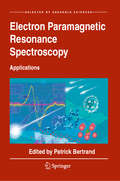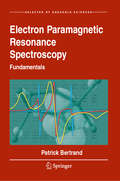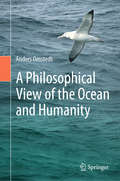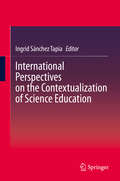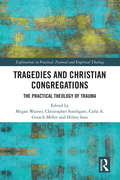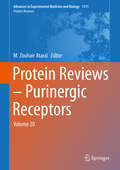- Table View
- List View
Recent Trends in Waste Water Treatment and Water Resource Management
by Sadhan Kumar Ghosh Papita Das Saha Maria Francesco DiThis book addresses a complex issue – water sustainability – that requires a combined approach to manage both water and energy. It highlights several technologies that have been introduced to study the water–energy linkage. It also discusses the need to develop effective laws for water management. In turn, the book assesses hybrid biological systems and demonstrates why they are better for the wastewater treatment process. Lastly, it reviews wastewater quality requirements, which have been the primary driver of industrial wastewater treatment programs in India. Gathering selected, high-quality research papers presented at the IconSWM 2018 conference, the book offers a valuable asset, not only for researchers and academics, but also for industrial practitioners and policymakers.
Theoretical Chemistry for Advanced Nanomaterials: Functional Analysis by Computation and Experiment
by Taku OnishiThis book collects recent topics of theoretical chemistry for advanced nanomaterials from the points of view of both computational and experimental chemistry. It is written for computational and experimental chemists, including undergraduate students, who are working with advanced nanomaterials, where collaboration and interplay between computation and experiment are essential.After the general introduction of nanomaterials, several computational approaches are explained in Part II. Each chapter presents not only calculation methods but also concrete calculation results for advanced nanomaterials. Hydride ion conducting nanomaterials, high-k dielectric nanomaterials, and organic electronics are focused on. In Part III, the interplay between computational and experimental approaches is explained. The chapters show calculation results, combined with corresponding experimental data. Dimensionality of nanomaterials, electronic structure of oligomers and nanorods, carbon nanomaterials, and the electronic structure of a nanosized sandwich cluster is looked at carefully. In Part IV, functionality analysis is explained from the point of view of the experimental approach. The emphasis is on the mechanism of photoluminescence and hydrogen generation using silicon nanopowder, the superionic conducting mechanism of glass ceramics, nanoclusters formation on the surface of metal oxides, and the magnetic property of an organic one-dimensional nanochannel. Finally, forthcoming theoretical methods for excited states and quantum dynamics are introduced in Part V.
Analytische Chemie I
by Ulf RitgenDas Arbeitsbuch führt durch das erfolgreiche Werk Harris, Lehrbuch der Quantitativen Analyse und ist vor allem für das Selbststudium konzipiert. In fünf Teilen werden die Vorlesungsinhalte der Analytischen Chemie zusammengefasst und anhand ausgewählter Beispiele erläutert. Grundbegriffe der Analytik werden ebenso dargelegt wie das Prinzip und die verschiedenen Techniken der Maßanalyse und der Chromatographie. Anhand von UV/VIS-, Infrarot- und Raman-Spektroskopie wird die Untersuchung molekular vorliegender Verbindungen erklärt, mit ausgewählten Techniken der Atomspektroskopie findet die Einführung in die Grundlagen der Analytik ihren Abschluss. Dabei wird immer wieder auf essenzielle Abschnitte und Abbildungen des Lehrbuches verwiesen, was das selbstständige Lernen der Grundlagen der Analytischen Chemie erleichtert.Leicht lesbar führt das Buch in die Grundlagen und die wichtigsten Techniken der Analytischen Chemie ein; es richtet sich an Studierende im Grundstudium der Chemie oder verwandter naturwissenschaftlicher Fächer. Dabei wird immer wieder auf die aus Lehrveranstaltungen der Allgemeinen Chemie bekannten Grundlagen Rückbezug genommen, sodass die Zusammenhänge zwischen bereits Bekanntem und Neuem sofort erkenntlich werden. Das Lernen mit diesem Arbeitsbuch ist in einem Fernstudiengang Chemie erprobt und erleichtert die Vorbereitung auf Modulprüfungen der Analytischen Chemie.
Der Mond: Von lunaren Dörfern, Schrammen und Lichtblitzen
by Karl UrbanKommen Sie mit diesem Buch dem Erdtrabanten näher: Wie sehen wir den Mond heute? Was wissen wir über Entstehung und Aufbau? Hat der Mond einen flüssigen Kern? Was bleibt vom Apollo-Programm und warum läuft aktuell ein neues Rennen zum Mond?In diesem Buch haben wir eine Reihe von allgemeinverständlichen Artikeln zusammengestellt, die unter anderem in Sterne und Weltraum, Wissenschaft im Brennpunkt (DLF) und der Neuen Züricher Zeitung veröffentlicht wurden und sich mit unserem kosmischen Begleiter auf vielfältige Weise beschäftigen:Was ist das Supermond-Phänomen?Was verraten uns Mondsteine?Wer baut das erste Dorf auf dem Mond?Was haben der Erdmond und der Asteroid Vesta gemeinsam?Was ist die Zukunft der astronautischen Raumfahrt?
Eindimensionale Finite Elemente: Ein Einstieg in die Methode
by Markus Merkel Andreas ÖchsnerDer Grundgedanke dieser Einführung in die Methode der Finiten Elemente wird von dem Konzept getragen, die komplexe Methode nur anhand eindimensionaler Elemente zu erläutern. Somit bleibt die mathematische Beschreibung weitgehend einfach und überschaubar. Das Augenmerk liegt in jedem Kapitel auf der Erläuterung der Methode und deren Verständnis selbst. Der Leser lernt die Annahmen und Ableitungen bei verschiedenen physikalischen Problemstellungen in der Strukturmechanik zu verstehen und Möglichkeiten und Grenzen der Methode der Finiten Elemente kritisch zu beurteilen. Die Beschränkung auf eindimensionale Elemente ermöglicht somit das methodische Verständnis wichtiger Themenbereiche (z.B. Plastizität oder Verbundwerkstoffe), die einem angehenden Berechnungsingenieur in der Berufspraxis begegnen, jedoch in dieser Form nur selten an Hochschulen behandelt werden. Somit ist ein einfacher Einstieg – auch in weiterführende Anwendungsgebiete – durch das Konzept (a) Einführung in die Grundlagen (b) exakte Ableitung bei Beschränkung auf eindimensionale Elemente (und in vielen Fällen auch auf eindimensionale Probleme) (c) Umfangreiche Beispiele und weiterführende Aufgaben (mit Kurzlösung im Anhang) gewährleistet.Zur Veranschaulichung wird jedes Kapitel sowohl mit ausführlich durchgerechneten und kommentierten Beispielen als auch mit weiterführenden Aufgaben inklusive Kurzlösungen vertieft.
Socio-Ecological Resilience to Climate Change in a Fragile Ecosystem: The Case of the Lake Chilwa Basin, Malawi (Earthscan Studies in Natural Resource Management)
by Sosten Chiotha Daniel Jamu Joseph Nagoli Patrick Likongwe Tembo ChanyengaThe Lake Chilwa Basin Climate Change Adaptation Programme was a seven-year research and development programme in Malawi that concluded in March 2017. The programme was designed to protect the livelihoods of the population and enhance resilience of the natural resource base upon which it depends. The Lake Chilwa Basin is an important wetland ecosystem which is a designated Ramsar Site under the Ramsar Wetland Convention and a Man and Biosphere Reserve designated by UNESCO. This book provides a review of the research and programme interventions done based on the ecosystem approach (EA), a strategy for the integrated management of land, water and living resources. This is designed to promote biodiversity conservation and sustainable use in an equitable way in its implementation of mitigation and climate change adaptation interventions. It is shown how: local and district institutions were strengthened to better manage natural resources and build resilience to climate change; cross-basin and cross-sector natural resource management and planning for climate change throughout the Basin were built; household and enterprise adaptive capacity in Basin hotspots was built; and improved forest management and governance contributed in mitigating the effects of climate change. The study followed all the twelve key EA principles with involvement of all key stakeholders. It is one of the first programmes to apply EA on such a wide temporal and spatial scale and provides key lessons to be learned for the protection of other fragile ecosystems in an era of climate change.
Socio-Ecological Resilience to Climate Change in a Fragile Ecosystem: The Case of the Lake Chilwa Basin, Malawi (Earthscan Studies in Natural Resource Management)
by Sosten Chiotha Daniel Jamu Joseph Nagoli Patrick Likongwe Tembo ChanyengaThe Lake Chilwa Basin Climate Change Adaptation Programme was a seven-year research and development programme in Malawi that concluded in March 2017. The programme was designed to protect the livelihoods of the population and enhance resilience of the natural resource base upon which it depends. The Lake Chilwa Basin is an important wetland ecosystem which is a designated Ramsar Site under the Ramsar Wetland Convention and a Man and Biosphere Reserve designated by UNESCO. This book provides a review of the research and programme interventions done based on the ecosystem approach (EA), a strategy for the integrated management of land, water and living resources. This is designed to promote biodiversity conservation and sustainable use in an equitable way in its implementation of mitigation and climate change adaptation interventions. It is shown how: local and district institutions were strengthened to better manage natural resources and build resilience to climate change; cross-basin and cross-sector natural resource management and planning for climate change throughout the Basin were built; household and enterprise adaptive capacity in Basin hotspots was built; and improved forest management and governance contributed in mitigating the effects of climate change. The study followed all the twelve key EA principles with involvement of all key stakeholders. It is one of the first programmes to apply EA on such a wide temporal and spatial scale and provides key lessons to be learned for the protection of other fragile ecosystems in an era of climate change.
Handbook of Humidity Measurement, Volume 3: Sensing Materials and Technologies
by Ghenadii KorotcenkovBecause of unique water properties, humidity affects materials and many living organisms, including humans. Humidity control is important in various fields, from production management to creating a comfortable living environment. The range of materials that can be used in the development of humidity sensors is very broad, and the third volume of the Handbook of Humidity Measurement offers an analysis on various humidity-sensitive materials and sensor technologies used in the fabrication of humidity sensors and methods acceptable for their testing. Additional features include: numerous strategies for the fabrication and characterization of humidity-sensitive materials and sensing structures used in sensor applications, methods and properties to develop smaller, cheaper, more robust, and accurate devices with better sensitivity and stability, a guide to sensor selection and an overview of the humidity sensor market, and new technology solutions for integration, miniaturization, and specificity of the humidity sensor calibration. Handbook of Humidity Measurement, Volume 3: Sensing Materials and Technologies provides valuable information for practicing engineers, measurement experts, laboratory technicians, project managers in industries and national laboratories, and university students and professors interested in solutions to humidity measurement tasks. Despite the fact that this book is devoted to the humidity sensors, it can be used as a basis for understanding fundamentals of any gas sensor operation and development.
Systems Engineering: Reliability Analysis Using k-out-of-n Structures
by Mangey Ram Tadashi DohiA substantial amount of research has been conducted on consecutive k-out-of-n and related reliability systems over the past four decades. These systems have been used to model various engineering systems such as the microwave stations of telecoms network, oil pipeline systems, and vacuum systems in an electron accelerator. As such, studies of reliability properties of consecutive k-out-of-n structures have attracted significant attention from both theoretical and practical approaches. In the modern era of technology, the redundancies are employed in the various industrial systems to prevent them from failure/sudden failure or to recover from failures. This book is meant to provide knowledge and help engineers and academicians in understanding reliability engineering by using k-out-of-n structures. The material is also targeted at postgraduate or senior undergraduate students pursuing reliability engineering.
Flexibility in Adaptation Planning: When, Where and How to Include Flexibility for Increasing Urban Flood Resilience (IHE Delft PhD Thesis Series)
by Mohanasundar RadhakrishnanThe magnitude and urgency of the need to adapt to climate change is such that addressing it has been taken up by the United Nations as one of the sustainable development goals - Goal 13 (SDG13) in 2015. SDG13 emphasises the need to strengthen resilience and adaptive capacity to climate related hazards and natural disasters. Coping with urban floods is one of the major needs of climate adaptation, where integration of climate change responses into flood risk management policies, strategies and planning at international, national, regional and local levels is now the norm. However, much of this integration lacks effectiveness or real commitment from stakeholders involved in adaptation planning and implementation. Hence this research has focused on integrating flexibility based adaptation responses into an urban flood risk management context. The research has synthesised flexible adaptation practices from several disciplines including information technology, automobile and aerospace manufacturing. The outcomes of the research are brought together in a framework for structuring local adaptation responses and an adaptation planning process based on flexibility concepts. The outcomes provide a way to assist with the identification of the appropriate nature and type of flexibility required; where flexibility can best be incorporated; and when is the most appropriate time to implement the flexible adaptation responses in the context of urban flooding.
Flexibility in Adaptation Planning: When, Where and How to Include Flexibility for Increasing Urban Flood Resilience (IHE Delft PhD Thesis Series)
by Mohanasundar RadhakrishnanThe magnitude and urgency of the need to adapt to climate change is such that addressing it has been taken up by the United Nations as one of the sustainable development goals - Goal 13 (SDG13) in 2015. SDG13 emphasises the need to strengthen resilience and adaptive capacity to climate related hazards and natural disasters. Coping with urban floods is one of the major needs of climate adaptation, where integration of climate change responses into flood risk management policies, strategies and planning at international, national, regional and local levels is now the norm. However, much of this integration lacks effectiveness or real commitment from stakeholders involved in adaptation planning and implementation. Hence this research has focused on integrating flexibility based adaptation responses into an urban flood risk management context. The research has synthesised flexible adaptation practices from several disciplines including information technology, automobile and aerospace manufacturing. The outcomes of the research are brought together in a framework for structuring local adaptation responses and an adaptation planning process based on flexibility concepts. The outcomes provide a way to assist with the identification of the appropriate nature and type of flexibility required; where flexibility can best be incorporated; and when is the most appropriate time to implement the flexible adaptation responses in the context of urban flooding.
Controlling Biofouling in Seawater Reverse Osmosis Membrane Systems (IHE Delft PhD Thesis Series)
by Nirajan DhakalSeawater desalination is a rapidly growing coastal industry that is increasingly threatened by algal blooms. Depending on the severity of algal blooms, desalination systems may be forced to shut down because of clogging and/or poor feed water quality. To maintain stable operation and provide good feed water quality to seawater reverse osmosis (SWRO) systems, ultrafiltration (UF) pre-treatment is proposed.This research focused on assessing the ability of UF and other pre-treatment technologies to reduce biofouling in SWRO systems. An improved method to measure bacterial regrowth potential (BRP) was developed and applied at laboratory, pilot and full scale to assess the ability of conventional UF (150 kDa) and tight UF (10 kDa) alone and in combination with a phosphate adsorbent to reduce regrowth potential and delay the onset of biofouling in SWRO.The improved bacterial regrowth potential method employs a natural consortium of marine bacteria as inoculum and flow cytometry. The limit of detection of the BRP method was lowered to 43,000 ± 12,000 cells/mL, which is equivalent to 9.3 ± 2.6 µg-Cglucose/L.The reduction in bacterial regrowth potential after tight UF (10 kDa) was 3 to 4 times higher than with conventional UF (150 kDa). It was further reduced after the application of a phosphate adsorbent, independent of pore size of the UF membrane. Pilot studies demonstrated that the application of tight UF (10 kDa) coupled with a phosphate adsorbent consistently lowered the bacterial regrowth potential and no feed channel pressure drop increase was observed in membrane fouling simulators (MFS) over a period of 21 days. The study also showed that non-backwashable fouling of UF membranes varied strongly with the type of algal species and the algal organic matter (AOM) they release. The presence of polysaccharide (stretching -OH) and sugar ester groups (stretching S=O) was the main cause of non-backwashable fouling.In conclusion, this study showed that an improved BRP method is suitable for the assessment of SWRO pre-treatment systems and it can be a useful tool to develop potential strategies to mitigate biofouling and improve the sustainability of SWRO systems.
Die Eigenschaften der Stoffe: Ein Überblick über die Definitionen in der Thermodynamik (essentials)
by Klaus StierstadtDieses essential gibt einen Überblick über die Definitionen von Suszeptibilitäten bzw. Responsefunktionen und von Transportkoeffizienten in Materie. Es zeigt, wie Suszeptibilitäten aus thermodynamischen Potenzialen berechnet werden können und wie man Transportkoeffizienten auf die Eigenschaften der Atome zurückführt. Das essential ist Teil einer dreiteiligen Reihe zur Thermodynamik, zusammen mit Temperatur und Wärme – was ist das wirklich? und Thermodynamische Potenziale und Zustandssumme.
Electron Paramagnetic Resonance Spectroscopy: Applications
by Patrick BertrandThis book shows how the fundamentals of electron paramagnetic resonance (EPR) spectroscopy are practically implemented and illustrates the diversity of current applications. The technique is used at various levels, and applications are presented in order of increasing difficulty, with reference to theoretically obtained results. This book features a diverse array of application examples, from fields such as ionizing radiation dosimetry, neurodegenerative diseases, structural transitions in proteins, and the origins of terrestrial life. The final chapter of this book highlights the principles and applications of the technique of ferromagnetic resonance spectroscopy, followed by a brief introduction to advanced EPR techniques such as electron spin echo envelope modulation (ESEEM), hyperfine sub-level correlation (HYSCORE), pulsed electron-electron double resonance (PELDOR), and continuous wave electron nuclear double resonance (ENDOR) experiments.
Electron Paramagnetic Resonance Spectroscopy: Fundamentals
by Patrick BertrandAlthough originally invented and employed by physicists, electron paramagnetic resonance (EPR) spectroscopy has proven to be a very efficient technique for studying a wide range of phenomena in many fields, such as chemistry, biochemistry, geology, archaeology, medicine, biotechnology, and environmental sciences. Acknowledging that not all studies require the same level of understanding of this technique, this book thus provides a practical treatise clearly oriented toward applications, which should be useful to students and researchers of various levels and disciplines. In this book, the principles of continuous wave EPR spectroscopy are progressively, but rigorously, introduced, with emphasis on interpretation of the collected spectra. Each chapter is followed by a section highlighting important points for applications, together with exercises solved at the end of the book. A glossary defines the main terms used in the book, and particular topics, whose knowledge is not required for understanding the main text, are developed in appendices for more inquisitive readers.
Controlling Biofouling in Seawater Reverse Osmosis Membrane Systems (IHE Delft PhD Thesis Series)
by Nirajan DhakalSeawater desalination is a rapidly growing coastal industry that is increasingly threatened by algal blooms. Depending on the severity of algal blooms, desalination systems may be forced to shut down because of clogging and/or poor feed water quality. To maintain stable operation and provide good feed water quality to seawater reverse osmosis (SWRO) systems, ultrafiltration (UF) pre-treatment is proposed.This research focused on assessing the ability of UF and other pre-treatment technologies to reduce biofouling in SWRO systems. An improved method to measure bacterial regrowth potential (BRP) was developed and applied at laboratory, pilot and full scale to assess the ability of conventional UF (150 kDa) and tight UF (10 kDa) alone and in combination with a phosphate adsorbent to reduce regrowth potential and delay the onset of biofouling in SWRO.The improved bacterial regrowth potential method employs a natural consortium of marine bacteria as inoculum and flow cytometry. The limit of detection of the BRP method was lowered to 43,000 ± 12,000 cells/mL, which is equivalent to 9.3 ± 2.6 µg-Cglucose/L.The reduction in bacterial regrowth potential after tight UF (10 kDa) was 3 to 4 times higher than with conventional UF (150 kDa). It was further reduced after the application of a phosphate adsorbent, independent of pore size of the UF membrane. Pilot studies demonstrated that the application of tight UF (10 kDa) coupled with a phosphate adsorbent consistently lowered the bacterial regrowth potential and no feed channel pressure drop increase was observed in membrane fouling simulators (MFS) over a period of 21 days. The study also showed that non-backwashable fouling of UF membranes varied strongly with the type of algal species and the algal organic matter (AOM) they release. The presence of polysaccharide (stretching -OH) and sugar ester groups (stretching S=O) was the main cause of non-backwashable fouling.In conclusion, this study showed that an improved BRP method is suitable for the assessment of SWRO pre-treatment systems and it can be a useful tool to develop potential strategies to mitigate biofouling and improve the sustainability of SWRO systems.
Estimating the Impacts of Urban Growth on Future Flood Risk: A Comparative Study (IHE Delft PhD Thesis Series)
by Willem VeerbeekThe unprecedented growth of cities has a significant impact on future flood risk that might exceed the impacts of climate change in many metropolitan areas across the world. Although the effects of urbanisation on flood risk are well understood, assessments that include spatially explicit future growth projections are limited. This comparative study provides insight in the long term development of future riverine and pluvial flood risk for 18 fast growing megacities. The outcomes provide not only a baseline absent in current practise, but also a strategic outlook that might better establish the role of urban planning in limiting future flood risk.
Estimating the Impacts of Urban Growth on Future Flood Risk: A Comparative Study (IHE Delft PhD Thesis Series)
by Willem VeerbeekThe unprecedented growth of cities has a significant impact on future flood risk that might exceed the impacts of climate change in many metropolitan areas across the world. Although the effects of urbanisation on flood risk are well understood, assessments that include spatially explicit future growth projections are limited. This comparative study provides insight in the long term development of future riverine and pluvial flood risk for 18 fast growing megacities. The outcomes provide not only a baseline absent in current practise, but also a strategic outlook that might better establish the role of urban planning in limiting future flood risk.
A Philosophical View of the Ocean and Humanity (Springerbriefs In Environmental Science Ser.)
by Anders OmstedtThis book is about the ocean and about the future. It is written in two modes, a concerned analytical scientific mode and an intuitive artistic mode in which the ocean is given a voice. The disconnect in the relationship between human dependency on and feelings about the ocean is examined in a dialogue between these two modes. The book illustrates how science and the arts can be connected to increase our awareness of the state of the ocean and support behavioural change. This book is intended for everyone who would like to contribute to the sustainable use of the ocean. Includes forewords by Alice Newton, University of Algarve, Portugal and Martin Visbeck, GEOMAR, Helmholtz Centre for Ocean Research, Kiel, Germany.
International Perspectives on the Contextualization of Science Education
by Ingrid Sánchez TapiaThis book explores how science learning can be more relevant and interesting for students and teachers by using a contextualized approach to science education. The contributors explore the contextualization of science education from multiple angles, such as teacher education, curriculum design, assessment and educational policy, and from multiple national perspectives. The aim of this exploration is to provide and inspire new practical approaches to bring science education closer to the lives of students to accelerate progress towards global scientific literacy. The book presents real life examples of how to make science relevant for children and adolescents of diverse ethnic and language backgrounds, socioeconomic status and nationalities, providing tools and guidance for teacher educators and researchers to improve the contextualization and cultural relevance of their practice. The book includes rigorous studies demonstrating that the contextualization of science learning environments is essential for student engagement in learning science and practitioners' reflections on how to apply this knowledge in the classroom and at national scale. This approach makes this book valuable for researchers and professors of science education and international education interested in designing teacher education courses that prepare future teachers to contextualize their teaching and in adding a critical dimension to their research agendas.
Treating the Body in Medicine and Religion: Jewish, Christian, and Islamic Perspectives (Routledge Studies in Religion)
by John J. Fitzgerald Ashley John MoyseModern medicine has produced many wonderful technological breakthroughs that have extended the limits of the frail human body. However, much of the focus of this medical research has been on the physical, often reducing the human being to a biological machine to be examined, understood, and controlled. This book begins by asking whether the modern medical milieu has overly objectified the body, unwittingly or not, and whether current studies in bioethics are up to the task of restoring a fuller understanding of the human person. In response, various authors here suggest that a more theological/religious approach would be helpful, or perhaps even necessary. Presenting specific perspectives from Judaism, Christianity and Islam, the book is divided into three parts: "Understanding the Body," "Respecting the Body," and "The Body at the End of Life." A panel of expert contributors—including philosophers, physicians, and theologians and scholars of religion— answer key questions such as: What is the relationship between body and soul? What are our obligations toward human bodies? How should medicine respond to suffering and death? The resulting text is an interdisciplinary treatise on how medicine can best function in our societies. Offering a new way to approach the medical humanities, this book will be of keen interest to any scholars with an interest in contemporary religious perspectives on medicine and the body.
Treating the Body in Medicine and Religion: Jewish, Christian, and Islamic Perspectives (Routledge Studies in Religion)
by John J. Fitzgerald Ashley John MoyseModern medicine has produced many wonderful technological breakthroughs that have extended the limits of the frail human body. However, much of the focus of this medical research has been on the physical, often reducing the human being to a biological machine to be examined, understood, and controlled. This book begins by asking whether the modern medical milieu has overly objectified the body, unwittingly or not, and whether current studies in bioethics are up to the task of restoring a fuller understanding of the human person. In response, various authors here suggest that a more theological/religious approach would be helpful, or perhaps even necessary. Presenting specific perspectives from Judaism, Christianity and Islam, the book is divided into three parts: "Understanding the Body," "Respecting the Body," and "The Body at the End of Life." A panel of expert contributors—including philosophers, physicians, and theologians and scholars of religion— answer key questions such as: What is the relationship between body and soul? What are our obligations toward human bodies? How should medicine respond to suffering and death? The resulting text is an interdisciplinary treatise on how medicine can best function in our societies. Offering a new way to approach the medical humanities, this book will be of keen interest to any scholars with an interest in contemporary religious perspectives on medicine and the body.
Tragedies and Christian Congregations: The Practical Theology of Trauma (Explorations in Practical, Pastoral and Empirical Theology)
by Christopher Southgate Carla Grosch-Miller Hilary Ison Megan WarnerWhen tragedy strikes a community, it is often unexpected with long-lasting effects on the people left in its wake. Too often, there aren’t adequate systems in place to aid those affected in processing what has happened. This study uniquely combines practical theology, pastoral insight and scientific data to demonstrate how Christian congregations can be helped to be resilient in the face of sudden devastating events. Beginning by identifying the characteristics of trauma in individuals and communities, this collection of essays from practitioners and academics locates sudden trauma-inducing tragedies as a problem in practical theology. A range of biblical and theological responses are presented, but contemporary scientific understanding is also included in order to challenge and stretch some of these traditional theological resources. The pastoral section of the book examines the ethics of response to tragedy, locating the role of the minister in relation to other helping agencies and exploring the all-too-topical issue of ministerial abuse. Developing a nuanced rationale for good practical, pastoral, liturgical and theological responses to major traumas, this book will be of significant value to scholars of practical theology as well as practitioners counselling in and around church congregations.
Tragedies and Christian Congregations: The Practical Theology of Trauma (Explorations in Practical, Pastoral and Empirical Theology)
by Megan Warner Christopher Southgate Carla A. Grosch-Miller Hilary IsonWhen tragedy strikes a community, it is often unexpected with long-lasting effects on the people left in its wake. Too often, there aren’t adequate systems in place to aid those affected in processing what has happened. This study uniquely combines practical theology, pastoral insight and scientific data to demonstrate how Christian congregations can be helped to be resilient in the face of sudden devastating events. Beginning by identifying the characteristics of trauma in individuals and communities, this collection of essays from practitioners and academics locates sudden trauma-inducing tragedies as a problem in practical theology. A range of biblical and theological responses are presented, but contemporary scientific understanding is also included in order to challenge and stretch some of these traditional theological resources. The pastoral section of the book examines the ethics of response to tragedy, locating the role of the minister in relation to other helping agencies and exploring the all-too-topical issue of ministerial abuse. Developing a nuanced rationale for good practical, pastoral, liturgical and theological responses to major traumas, this book will be of significant value to scholars of practical theology as well as practitioners counselling in and around church congregations.
Protein Reviews – Purinergic Receptors: Volume 20 (Advances in Experimental Medicine and Biology #1111)
by M. Zouhair AtassiThe Protein Reviews series serves as a publication vehicle for reviews that focus on crucial contemporary and vital aspects of protein structure, function, evolution and genetics. Volume 20, Purinergic Receptors, has ten chapters. The first five chapters deal with various aspects of membrane binding. The first chapter focuses on the phox-homology (PX) domain, which is a phosphoinositide-binding domain conserved in all eukaryotes and present in forty-nine human proteins. The next chapter deals with the modeling of PH domains/phosphoinositides interactions. This is followed by a chapter on BAR domain proteins regulate Rho GTPase signaling. The BAR (Bin–Amphiphysin–Rvs) domain is a membrane lipid binding domain present in a wide variety of proteins, often proteins with a role in Rho-regulated signaling pathways. The fourth article presents AP180 N-terminal homology (ANTH) and Epsin N-terminal homology (ENTH) domains and discusses their physiological functions and involvement in disease. The fifth article reviews the polyphosphoinositide-binding domains and presents insights from peripheral membrane and lipid-transfer proteins. This is followed by a chapter on the physiological functions of phosphoinositide-modifying enzymes and their interacting proteins in Arabidopsis, then by a chapter on the molecular mechanisms of Vaspin action in various tissues such as adipose tissue, skin, bone, blood vessels, and the brain. The eighth chapter deals with exceptionally selective substrate targeting by the metalloprotease anthrax lethal factor followed by an article on Salmonella, E. coli, and Citrobacter type III secretion system effector proteins that alter host innate immunity. The last chapter presents New techniques to study intracellular receptors in living cells, with insights into RIG-I-like receptor signaling. Volume 20 is intended for research scientists, clinicians, physicians and graduate students in the fields of biochemistry, cell biology, molecular biology, immunology and genetics.











